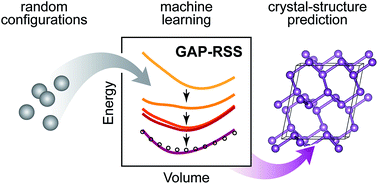当前位置:
X-MOL 学术
›
Faraday Discuss.
›
论文详情
Our official English website, www.x-mol.net, welcomes your
feedback! (Note: you will need to create a separate account there.)
Data-driven learning and prediction of inorganic crystal structures
Faraday Discussions ( IF 3.3 ) Pub Date : 2018-04-12 , DOI: 10.1039/c8fd00034d Volker L. Deringer 1, 2, 3, 4, 5 , Davide M. Proserpio 6, 7, 8, 9, 10 , Gábor Csányi 1, 2, 3, 4 , Chris J. Pickard 2, 4, 11, 12, 13
Faraday Discussions ( IF 3.3 ) Pub Date : 2018-04-12 , DOI: 10.1039/c8fd00034d Volker L. Deringer 1, 2, 3, 4, 5 , Davide M. Proserpio 6, 7, 8, 9, 10 , Gábor Csányi 1, 2, 3, 4 , Chris J. Pickard 2, 4, 11, 12, 13
Affiliation

|
Crystal structure prediction algorithms, including ab initio random structure searching (AIRSS), are intrinsically limited by the huge computational cost of the underlying quantum-mechanical methods. We have recently shown that a novel class of machine learning (ML) based interatomic potentials can provide a way out: by performing a high-dimensional fit to the ab initio energy landscape, these potentials reach comparable accuracy but are orders of magnitude faster. In this paper, we develop our approach, dubbed Gaussian approximation potential-based random structure searching (GAP-RSS), towards a more general tool for exploring configuration spaces and predicting structures. We present a GAP-RSS interatomic potential model for elemental phosphorus, which identifies and correctly “learns” the orthorhombic black phosphorus (A17) structure without prior knowledge of any crystalline allotropes. Using the tubular structure of fibrous phosphorus as an example, we then discuss the limits of free searching, and discuss a possible way forward that combines a recently proposed fragment analysis with GAP-RSS. Examples of possible tubular (1D) and extended (3D) hypothetical allotropes of phosphorus as found by GAP-RSS are discussed. We believe that in the future, ML potentials could become versatile and routine computational tools for materials discovery and design.
中文翻译:

数据驱动的无机晶体结构的学习和预测
晶体结构预测算法(包括从头开始的随机结构搜索(AIRSS))本质上受到底层量子力学方法的巨大计算成本的限制。我们最近表明,一类新颖的基于机器学习(ML)的原子间电势可以提供一种出路:通过对从头算起进行高维拟合在能源领域,这些潜力可以达到可比的精度,但速度要快几个数量级。在本文中,我们开发了一种称为高斯近似势能的随机结构搜索(GAP-RSS)方法,旨在开发一种更通用的工具来探索配置空间和预测结构。我们提出了一种用于元素磷的GAP-RSS原子间原子势模型,该模型可以识别和正确“学习”正交六方黑磷(A17)结构,而无需任何晶体同素异形体的先验知识。以纤维状磷的管状结构为例,然后我们讨论了自由搜索的局限性,并讨论了将最近提出的片段分析与GAP-RSS相结合的一种可能的方法。讨论了可能的管状(1D)和扩展(3D)假设的磷同素异形体(如通过GAP-RSS发现)的示例。我们相信,未来,机器学习潜力将成为用于材料发现和设计的通用和常规计算工具。
更新日期:2018-10-26
中文翻译:

数据驱动的无机晶体结构的学习和预测
晶体结构预测算法(包括从头开始的随机结构搜索(AIRSS))本质上受到底层量子力学方法的巨大计算成本的限制。我们最近表明,一类新颖的基于机器学习(ML)的原子间电势可以提供一种出路:通过对从头算起进行高维拟合在能源领域,这些潜力可以达到可比的精度,但速度要快几个数量级。在本文中,我们开发了一种称为高斯近似势能的随机结构搜索(GAP-RSS)方法,旨在开发一种更通用的工具来探索配置空间和预测结构。我们提出了一种用于元素磷的GAP-RSS原子间原子势模型,该模型可以识别和正确“学习”正交六方黑磷(A17)结构,而无需任何晶体同素异形体的先验知识。以纤维状磷的管状结构为例,然后我们讨论了自由搜索的局限性,并讨论了将最近提出的片段分析与GAP-RSS相结合的一种可能的方法。讨论了可能的管状(1D)和扩展(3D)假设的磷同素异形体(如通过GAP-RSS发现)的示例。我们相信,未来,机器学习潜力将成为用于材料发现和设计的通用和常规计算工具。











































 京公网安备 11010802027423号
京公网安备 11010802027423号